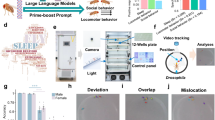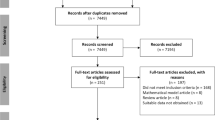Abstract
The frequency and unpredictability of predator attacks can substantially influence vigilance patterns in prey animals. However, the lack of control over predator behavior hampers our understanding of the effect of predator attack patterns on vigilance. To circumvent this limitation, I developed a virtual experiment in which the behavior of the (virtual) predator was under full control of the experimenter. In the virtual experiment, I altered the frequency and unpredictability of attacks to document how human subjects (N = 45), which acted as surrogate prey, altered their vigilance in response to changes in predator attack patterns. Subjects increased the frequency of their vigilance bouts when the virtual predator attacked more frequently and increased vigilance bout duration when the predator attacked more unpredictably, thus showing an increase in vigilance when predation risk increased. Other features of vigilance in the virtual environment also fitted predictions from current theories of vigilance. In particular, subjects overemphasized safety in the early stages of the experiment when learning about predator attack patterns. Strong individual differences in both the frequency and duration of vigilance bouts also emerged in the virtual environment. Such individual differences feature prominently in the vigilance literature in birds and mammals. The virtual environment thus provides a unique tool to assess vigilance patterns in a controlled environment.
Significance statement
Predator attacks can vary substantially in frequency and unpredictability. Patterns of predator attacks are likely to influence vigilance patterns in prey animals. However, the lack of control over predator behavior hampers our understanding of the effect of predator attack patterns on vigilance. To circumvent this limitation, I developed a virtual experiment in which the predator was under full control of the experimenter. I altered the frequency and unpredictability of attacks to document how human subjects, which acted as surrogate prey, altered their vigilance in response to changes in predator attack patterns. The results show that subjects changed the frequency and duration of vigilance bouts in response to changes in predator attack patterns. The virtual experiment provides a unique tool to assess vigilance patterns in a controlled environment.


Similar content being viewed by others
References
Ale SB, Brown JS (2007) The contingencies of group size and vigilance. Evol Ecol Res 9:1263–1276
Atkins A, Redpath SM, Little RM, Amar A (2017) Experimentally manipulating the landscape of fear to manage problem animals. J Wildlife Manage 81:610–616
Bar-Haim Y, Lamy D, Pergamin L, Bakermans-Kranenburg MJ, van IJzendoorn MH (2007) Threat-related attentional bias in anxious and nonanxious individuals: a meta-analytic study. Psychol Bull 133:1–24
Bateson M, Brilot B, Nettle D (2011) Anxiety: an evolutionary approach. Can J Psychiatr 56:707–715
Beauchamp G (2008) What is the magnitude of the group-size effect on vigilance? Behav Ecol 19:1361–1368
Beauchamp G (2015) Animal vigilance: monitoring predators and competitors. Academic Press, London
Beauchamp G, Ruxton GD (2003) Changes in vigilance with group size under scramble competition. Am Nat 161:672–675
Beauchamp G, Ruxton GD (2008) Disentangling risk dilution and collective detection in the antipredator vigilance of semipalmated sandpipers in flocks. Anim Behav 75:1837–1842
Beauchamp G, Ruxton GD (2012a) Changes in anti-predator vigilance over time caused by a war of attrition between predator and prey. Behav Ecol 23:368–374
Beauchamp G, Ruxton GD (2012b) Vigilance decreases with time at loafing sites in gulls (Larus spp.). Ethology 118:733–739
Beauchamp G, Ruxton GD (2016) Modeling scan and interscan durations in antipredator vigilance. J Theor Biol 390:86–96
Bednekoff PA, Blumstein DT (2009) Peripheral obstructions influence marmot vigilance: integrating observational and experimental results. Behav Ecol 20:1111–1117
Boujja-Miljour H, Leighton PA, Beauchamp G (2018) Individual vigilance profiles in flocks of house sparrows (Passer domesticus). Can J Zool 96:1016–1023
Bouskila A, Blumstein DT (1992) Rules of thumb for hazard assessment: predictions from a dynamic model. Am Nat 139:161–176
Caraco T, Martindale S, Pulliam HR (1980) Avian flocking in the presence of a predator. Nature 285:400–401
Caro TM (2005) Antipredator defenses in birds and mammals. University of Chicago Press, Chicago
Carter AJ, Pays O, Goldizen AW (2009) Individual variation in the relationship between vigilance and group size in eastern grey kangaroos. Behav Ecol Sociobiol 64:237–245
Clark CW, Mangel M (1986) The evolutionary advantages of group foraging. Theor Pop Biol 30:45–75
Creel S, Schuette P, Christianson D (2014) Effects of predation risk on group size, vigilance, and foraging behavior in an African ungulate community. Behav Ecol 25:773–784
Dunbar RIM, Cornah L, Daly FJ, Bowyer KM (2002) Vigilance in human groups: a test of alternative hypotheses. Behaviour 139:695–711
Edwards AM, Best EC, Blomberg SP, Goldizen AW (2013) Individual traits influence vigilance in wild female eastern grey kangaroos. Aust J Zool 61:332–341
Fairbanks B, Dobson FS (2007) Mechanisms of the group-size effect on vigilance in Columbian ground squirrels: dilution versus detection. Anim Behav 73:115–123
Favreau F-R, Goldizen AW, Pays O (2010) Interactions among social monitoring, anti-predator vigilance and group size in eastern grey kangaroos. Proc R Soc B 277:2089–2095
Favreau F-R, Goldizen AW, Fritz H, Blomberg SP, Best EC, Pays O (2014) Within-population differences in personality and plasticity in the trade-off between vigilance and foraging in kangaroos. Anim Behav 92:175–184
Fernández-Juricic E (2012) Sensory basis of vigilance behavior in birds: synthesis and future prospects. Behav Process 89:143–152
Fisher KA, Stankowich T (2018) Antipredator strategies of striped skunks in response to cues of aerial and terrestrial predators. Anim Behav 143:25–34
Frid A (1997) Vigilance by female Dall’s sheep: interaction between predation risk factors. Anim Behav 53:799–808
Gomes N, Semin GR (2020) Mapping human vigilance: the influence of conspecifics. Evol Hum Behav 41:69–75
Gurven M, Hill K (2009) Why do men hunt? A reevaluation of “man the hunter” and the sexual division of labor. Curr Anthropol 50:51–74
Hart D, Sussman RW (2009) Man the hunted: primates, predators, and human evolution. Westview, Boulder
Headland TN, Greene HW (2011) Hunter–gatherers and other primates as prey, predators, and competitors of snakes. P Natl Acad Sci USA 108:E1470–E1474
Hirsch BT (2002) Social monitoring and vigilance behavior in brown capuchin monkeys (Cebus apella). Behav Ecol Sociobiol 52:458–464
Jackson AL, Brown S, Sherratt TN, Ruxton GD (2005) The effects of group size, shape and composition on ease of detection of cryptic prey. Behaviour 142:811–826
Kameda T, Tamura R (2007) “To eat or not to be eaten?” Collective risk-monitoring in groups. J Exp Soc Psychol 43:168–179
Kent MIA, Herbert-Read JE, McDonald G, Wood AJ, Ward AJW (2019) Fine-scale behavioural adjustments of prey on a continuum of risk. Proc R Soc B 286:20190448
Lendrem DW (1984) Flocking, feeding and predation risk: absolute and instantaneous feeding rates. Anim Behav 32:298–299
Lima SL (1998) Stress and decision making under the risk of predation: recent developments from behavioral, reproductive, and ecological perspectives. Adv Stud Behav 27:215–290
Lima SL (2002) Putting predators back into behavioral predator-prey interactions. Trends Ecol Evol 17:70–75
Lima SL, Zollner PA, Bednekoff PA (1999) Predation, scramble competition, and the vigilance group size effect in dark-eyed juncos (Junco hyemalis). Behav Ecol Sociobiol 46:110–116
Mathot KJ, van den Hout PJ, Piersma T, Kempenaers B, Réale D, Dingemanse NJ (2011) Disentangling the roles of frequency-vs. state-dependence in generating individual differences in behavioural plasticity. Ecol Lett 14:1254–1262
Maximino C, de Brito TM, Gouveia A Jr (2010) Construct validity of behavioral models of anxiety: where experimental psychopathology meets ecology and evolution. Psychol Neurosci 3:117–123
McNamara JM, Houston AI (1992) Evolutionarily stable levels of vigilance as a function of group size. Anim Behav 43:641–658
Mobbs D, Hagan CC, Dalgleish T, Silston B, Prévost C (2015) The ecology of human fear: survival optimization and the nervous system. Front Neurosci 9:55
Mobbs D, Trimmer PC, Blumstein DT, Dayan P (2018) Foraging for foundations in decision neuroscience: insights from ethology. Nat Rev Neurosci 19:419–427
Monclús R, Rodel HG, von Holst D (2006) Fox odour increases vigilance in European rabbits: a study under semi-natural conditions. Ethology 112:1186–1193
Ortiz CA, Pendleton EL, Newcomb KL, Smith JE (2019) Conspecific presence and microhabitat features influence foraging decisions across ontogeny in a facultatively social mammal. Behav Ecol Sociobiol 73:42
Pangle WM, Holekamp KE (2010) Functions of vigilance behaviour in a social carnivore, the spotted hyaena, Crocuta crocuta. Anim Behav 80:257–267
Périquet S, Todd-Jones L, Valeix M et al (2012) Influence of immediate predation risk by lions on the vigilance of prey of different body size. Behav Ecol 23:970–976
Pulliam HR (1973) On the advantages of flocking. J Theor Biol 38:419–422
Pulliam HR, Pyke GH, Caraco T (1982) The scanning behavior of juncos: a game-theoretical approach. J Theor Biol 95:89–103
Rieucau G, Morand-Ferron J, Giraldeau L-A (2010) Group size effect in nutmeg mannikin: between-individuals behavioral differences but same plasticity. Behav Ecol 21:684–689
Rieucau G, Blanchard P, Martin JGA, Favreau F-R, Goldizen AW, Pays O (2012) Investigating differences in vigilance tactic use within and between the sexes in eastern grey kangaroos. PLoS One 7:e44801
Roberts G (1996) Why individual vigilance declines as group size increases. Anim Behav 51:1077–1086
Ruxton GD, Jackson AL, Tosh CR (2007) Confusion of predators does not rely on specialist coordinated behavior. Behav Ecol 18:590–596
Scott-Samuel NE, Holmes G, Baddeley R, Cuthill IC (2015) Moving in groups: how density and unpredictable motion affect predation risk. Behav Ecol Sociobiol 69:867–872
Sih A, Mathot KJ, Moirón M, Montiglio P-O, Wolf M, Dingemanse NJ (2015) Animal personality and state–behaviour feedbacks: a review and guide for empiricists. Trends Ecol Evol 30:50–60
Sirot E, Pays O (2011) On the dynamics of predation risk perception for a vigilant forager. J Theor Biol 276:1–7
Stoet G (2010) PsyToolkit: a software package for programming psychological experiments using Linux. Behav Res Methods 42:1096–1104
Terhune JM, Brillant SW (1996) Harbour seal vigilance decreases over time since haul out. Anim Behav 51:757–763
Tosh CR, Jackson AL, Ruxton GD (2006) The confusion effect in predatory neural networks. Am Nat 167:E52–E65
Trouilloud W, Delisle A, Kramer DL (2004) Head raising during foraging and pausing during intermittent locomotion as components of antipredator vigilance in chipmunks. Anim Behav 67:789–797
van der Marel A, López-Darias M, Waterman JM (2019) Group-enhanced predator detection and quality of vigilance in a social ground squirrel. Anim Behav 151:43–52
Wheeler HC, Hik DS (2014) Giving-up densities and foraging behaviour indicate possible effects of shrub encroachment on arctic ground squirrels. Anim Behav 95:1–8
Winterhalder B, Smith EA (1981) Hunter-gatherer foraging strategies. University of Chicago Press, Chicago
Wirtz P, Wawra M (1986) Vigilance and group size in Homo sapiens. Ethology 71:283–286
Yorzinski JL, Platt ML (2014) Selective attention in peacocks during predator detection. Anim Cogn 17:767–777
Yorzinski JL, Penkunas MJ, Platt ML, Coss RG (2014) Dangerous animals capture and maintain attention in humans. Evol Psychol 12:534–548
Acknowledgments
I thank my three beta-testers Florent Dery, Barbara Vuillaume, and Sophiane Béland for constructive feedbacks on the virtual experiment and all colleagues who participated in the study. I thank two anonymous reviewers for constructive comments.
Author information
Authors and Affiliations
Ethics declarations
Conflict of interest
The author declares that he has no conflict of interest.
Ethical approval
Subjects gave their prior consent to participate in the study. To protect personal information, all data were collected anonymously.
Additional information
Communicated by P. A. Bednekoff
Publisher’s note
Springer Nature remains neutral with regard to jurisdictional claims in published maps and institutional affiliations.
Rights and permissions
About this article
Cite this article
Beauchamp, G. Predator attack patterns influence vigilance in a virtual experiment. Behav Ecol Sociobiol 74, 49 (2020). https://doi.org/10.1007/s00265-020-02833-0
Received:
Revised:
Accepted:
Published:
DOI: https://doi.org/10.1007/s00265-020-02833-0




